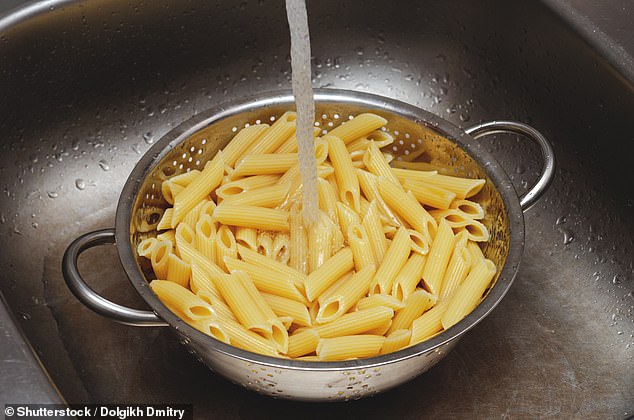You’ve been preparing your pasta all wrong! Expert reveals the one step you should never take when making Italian dish (even if the food packet tells you to!)
For many of us, pasta is the main ingredient for a simple weekday meal. However, preparing it is not as easy as the back of the packaging suggests.
While most ready-made pasta packages for home cooks prescribe a specific measure to prevent the pasta from sticking together during cooking, it turns out they’re missing a trick.
Fans of this Italian dish have probably long since rinsed their cooked pasta with cold water to prevent it from sticking together. But people who really know how to cook would like to do this.
The website Food Republic (founded by award-winning chef and cookbook author Marcus Samuelsson), for example, compares rinsing pasta to “pour[ing]liquid gold down the drain.”
It says, ‘If you put noodles in a colander and pour water over them after cooking, you might think that will make them less sticky.
It has long been thought that cooked pasta should be rinsed under cold water to prevent the individual pieces from sticking together, but cooking experts disagree (stock photo)
“But you also wash away important starch from the surfaces.”
And according to the website, if you rinse the pasta and remove the starch, you will damage the dish you are trying to make.
This is because the starch acts as a kind of ‘glue’, improving the taste of the final product.
The website described the “water left over after cooking pasta” as a “magical brew.”
Instead of throwing the pasta down the sink, cooks should “set aside a cup or two” before draining the pasta and “then add it back to the sauce as you toss the pasta.”
The starch in the water helps the sauce to mix with the pasta, rather than just sitting on top, which in turn makes the dish more flavorful.
There is, however, one situation where rinsing pasta with cold water is the right thing to do.
For example, if you are making a pasta salad, you can rinse the pasta under cold water after cooking. This will stop the cooking process and prevent the pasta salad from becoming mushy.

For example, the website Food Republic (founded by award-winning chef and cookbook author Marcus Samuelsson) compares rinsing pasta to “flushing liquid gold down the drain” (stock photo)
Another thing to consider when cooking pasta is the cost. There are ways to reduce this.
According to scientists at Nottingham Trent University, there is an optimal method that can save you up to 6.5 cents per serving.
This involves first soaking dried pasta in cold water for two hours and then cooking it for one to two minutes in gently simmering water at 80°C (176°F).
As for the amount of water in the pan, the scientists calculated that using half the standard one-liter amount was more cost-effective, while not affecting the texture or quality of the pasta in any way.
The first thing the experts looked at was what happens to pasta when it is cooked.
Two processes occur simultaneously: first, the rehydration and softening of dried pasta within ten minutes of cooking in boiling water, and second, the heating of it, which causes the proteins to expand and become edible.
The research found that the cost of cooking pasta on ceramic hobs was 12.7p, on induction hobs 10.6p and on gas hobs 7p. This depends on the standard cooking method of placing 100g of pasta in one litre of boiling water for ten to twelve minutes.
Scientists at Nottingham Trent therefore looked at how they could reduce these costs by analysing how much energy is used during the cooking process.
They estimate that as much as 60 percent of the energy is used to keep the water boiling, so any way to reduce the boiling time would have a big impact on the total cost.
That’s where the two processes come in. The first, hydrating the paste, doesn’t actually require any heating at all. All it needs is water.
According to the scientists, gourmets can rehydrate dried pasta by placing it in cold water for two hours, instead of boiling the pasta in water for 12 minutes.
Because there is no heat involved, no energy is used. This saves you a total of 6p on serving costs.
In fact, if you turn off the stove halfway through the cooking time and let the pasta sit in the residual heat, you’ll save about 3 cents.
The cold-water immersion completes one process of cooking pasta, but it fails to do the other, which is heating it and expanding proteins. But there are other ways to save your pennies, the scientists say.
That’s because they discovered that if you halve the amount of water to 500ml, you still get delicious pasta, so it takes less time to heat up and uses less energy.
Less water not only uses less energy, but according to the experts, there is also no need to heat the water to 100°C. If you simmer the water at 80°C, the protein granules will still dissolve.
According to the study, this temperature reduction saves about 0.5 cents per serving.
However, 500ml is the limit, because reducing the water volume to a third did not work. It allowed too much starch to form in the pan and resulted in lumps of unevenly cooked pasta.
Heating pre-soaked pasta in the microwave also didn’t work, as it produced the worst quality noodles of the entire experiment.
The research was shared by David Fairhurst, a lecturer at Nottingham Trent University, on The conversation.
